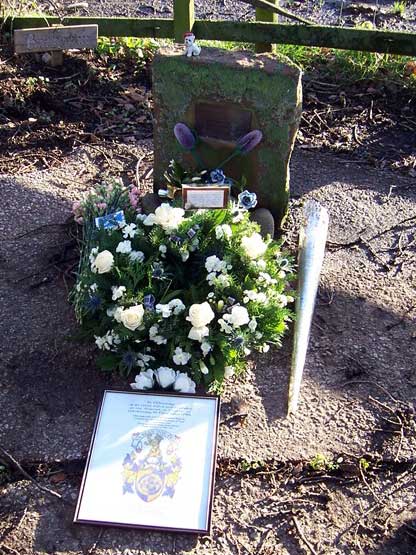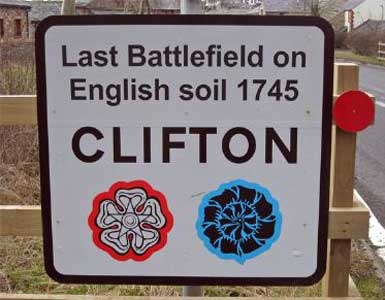THE BATTLE OF CLIFTON MOOR 1745 |
 |
The Skirmish at Clifton Moor took place between forces of the British Hanovarian goverment and Jacobite rebels on the 19th December 1745. With the commander of British forces, the Duke of Cumberland being aware of the Jacobite presence in Derby the Jacobite leader Prince Charles Edward Stuart decided to retreat north back towards Scotland. Charles began his retreat from Derby on the 6th of December 1745. This was the last battle on English soil between Bonnie Prince Charlie's and the Duke of Cumberland's forces.
The remainder of the army which had stayed at Leek came to Macclesfield the next day and those who had styed the night at Macclesfield went on to Stockport. On the 9th both of the Jacobite divisions met on the road to Manchester and entered the city as one body. The Jacobite army left Manchester on the 10th and reached Wigan that night. The next day they reached Preston where they stayed until the 12th. |
James Drummond, the Duke of Perth was despatched with 100 horse to travel north and bring back reinforcements from Perth. The Prince and his Jacobite army arrived in Lancaster on the evening of the 13th. Charles had made a decision to stay and fight at Lancaster. A survey of the surrounding ground at Lancaster was carried out by the Jacobite commanders Lord George Murray and Cameron of Lochiel. They found the ground suitable for there army to fight on however Lord George Murray had also received reports that a large body of General George Wade's dragoons had enterd Preston not long after they had left. However Charles had changed his mind and decided to continue with their march back north. |
Arrival at Clifton |
| On the morning of the 18th the Jacobite rearguard left Shap. It had not proceeded far when some parties of English light horse were seen in the distance on the eminences behind the rear-guard. Lord George Murray notified the circumstances to Charles at Penrith; but it was believed that these were militia and the information was treated lightly. On the 18th a body of between 200 and 300 horse of the Duke of Cumberland's forces, formed in front of the rear-guard, to make a stand. The government party was observed marching two and two abreast on the top of the hill. They disappeared to form themselves in order of battle behind the eminence, and made a great noise with trumpets and kettledrums. At this time two of the companies of Roy Stuart's regiment, which the Duke of Perth had attached to the artillery, were at the head of the column. The guns and ammunition wagons followed, behind the two other companies of the same regiment. |
 |
The Clan MacDonnell of Glengarry regiment, which marched with Lord George Murray at its head, was in the rear of the column. Believing, from the great number of trumpets and kettle-drums, that the British army was at hand, the Jacobites remained stationary for a short time. |
The Skirmish |
 |
About an hour after the Duke of Cumberland had formed his men, about 500 of his dragoons dismounted and advanced forward to the foot of the moor, in front of a ditch at the bottom of one of three small inclosures between the moor and the places where Roy Stuart's men were posted at the village. At this time Colonel Stuart returned from Penrith, and, after informing Lord George that the prince had resolved to march immediately to Carlisle, and that he had sent forward his cannon, he stated that it was his royal highness's desire that he should immediately retreat to Penrith. From the situation in which the Lieutenant-general was now placed, it was impossible to obey this order without great danger. The dismounted horse were already firing upon the Jacobites. Lord George proposed to attack the dismounted party. Lord George Murray went to the right where the Macdonnell of Glengarry men were posted, and ordered them, as soon as they should observe him advance on the other side, to move also forward and keep up a smart fire until they came to the lowest ditch. He observed that if they succeeded in dislodging the enemy from the hedges and ditches, they could give them a flank fire within pistol-shot but he gave them particular orders not to fire across the highway, or to follow the enemy up the moor. After speaking with every officer of the Glengarry regiment, Murray returned to the left, and placed himself at the head of the Macphersons. It was now about an hour after sunset, and the night was somewhat cloudy; but at short intervals the moon, which was in its second quarter, broke through and afforded considerable light. The Jacobites had to their advantage, that whilst they could see the disposition of the enemy, their own movements could not be observed. |
The Stewarts and Macphersons marched forward at the word of command, as did the Macdonalds and MacDonnells on the right. The men on the on the right kept firing as they advanced but the Macphersons, who were on the left, soon came into contact with the English dragoons, and received the whole of their fire. Murray then drawing his sword, he cried out, "Claymore!", and Cluny Macpherson doing the same, the Macphersons rushed down to the bottom ditch of the inclosure, and clearing the diagonal hedges as they went, fell sword in hand upon the enemy, of whom a considerable number were killed at the lower ditch. The rest retreated across the moor, but received in their flight the fire of the MacDonnell of Glengarry regiment. |
Aftermath |
In the skirmish only twelve Jacobites were killed but the Government forces sustained a loss of about one hundred in killed and wounded, including some officers. The only officer wounded on the side of the Jacobites was the Macdonald of Glengarry chief. Lord George Murray made several narrow escapes. |
 |
© Paisley Tartan Army 2008-09
